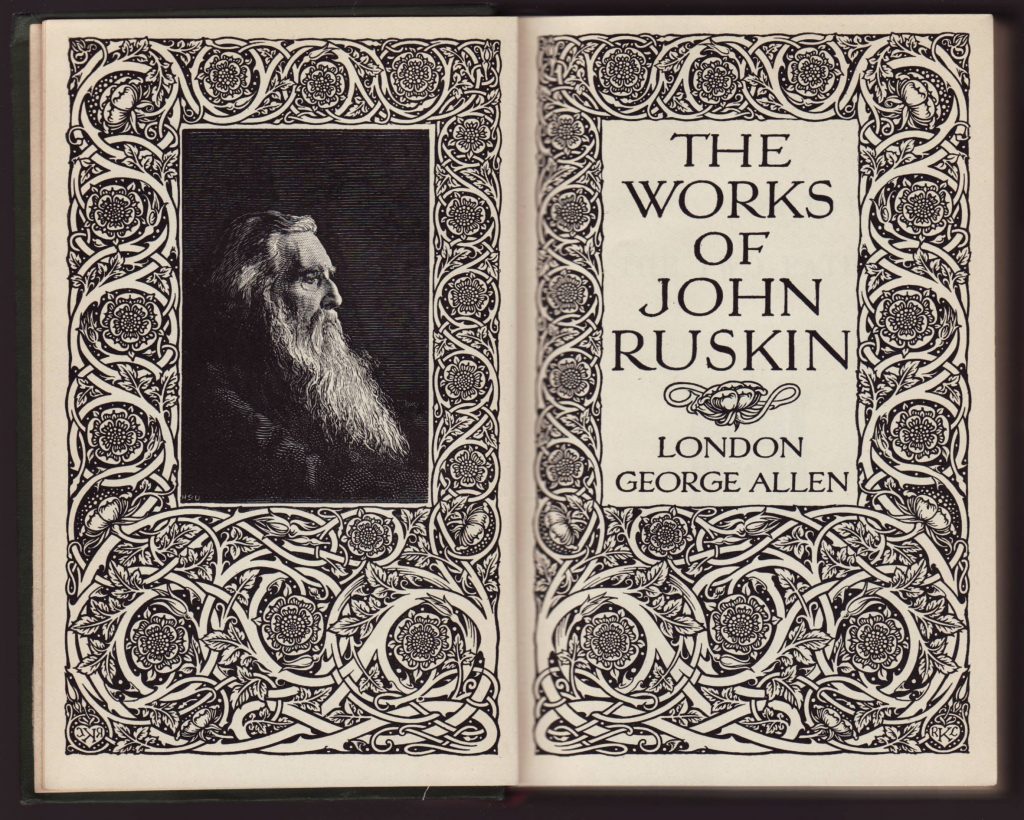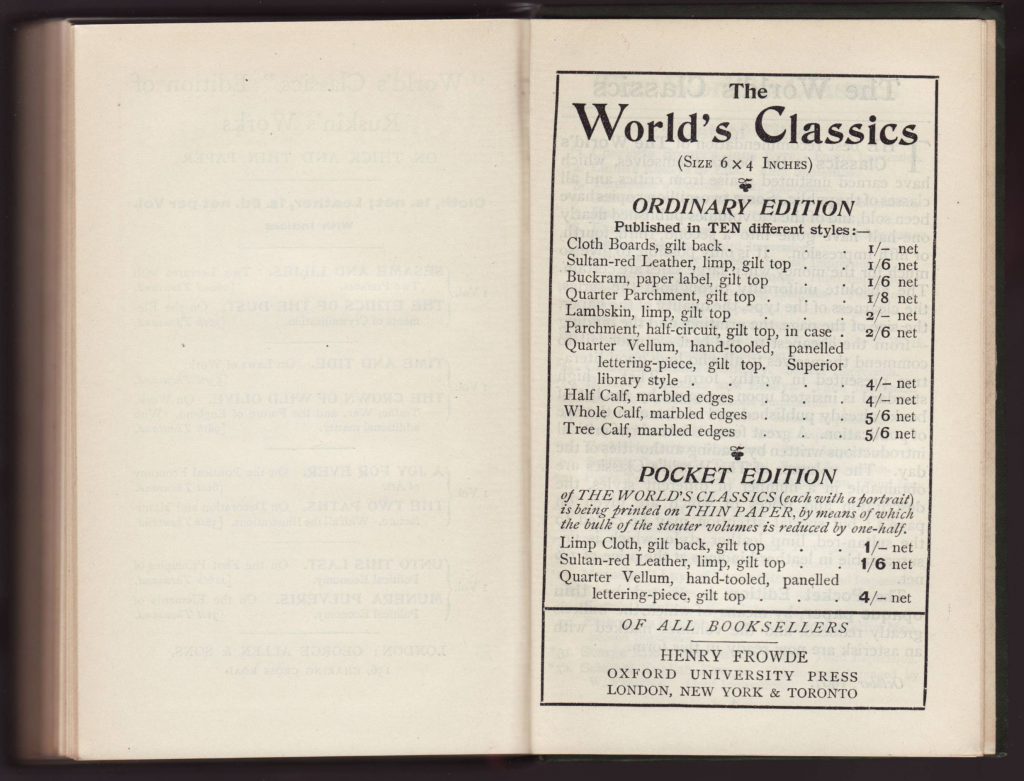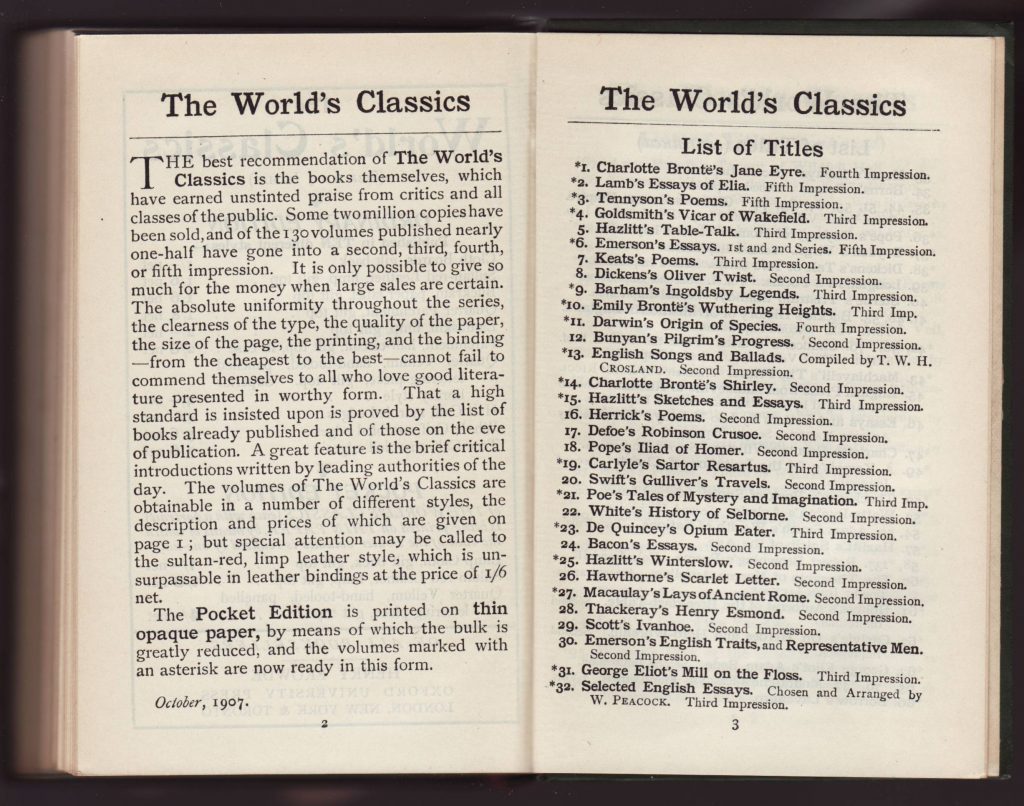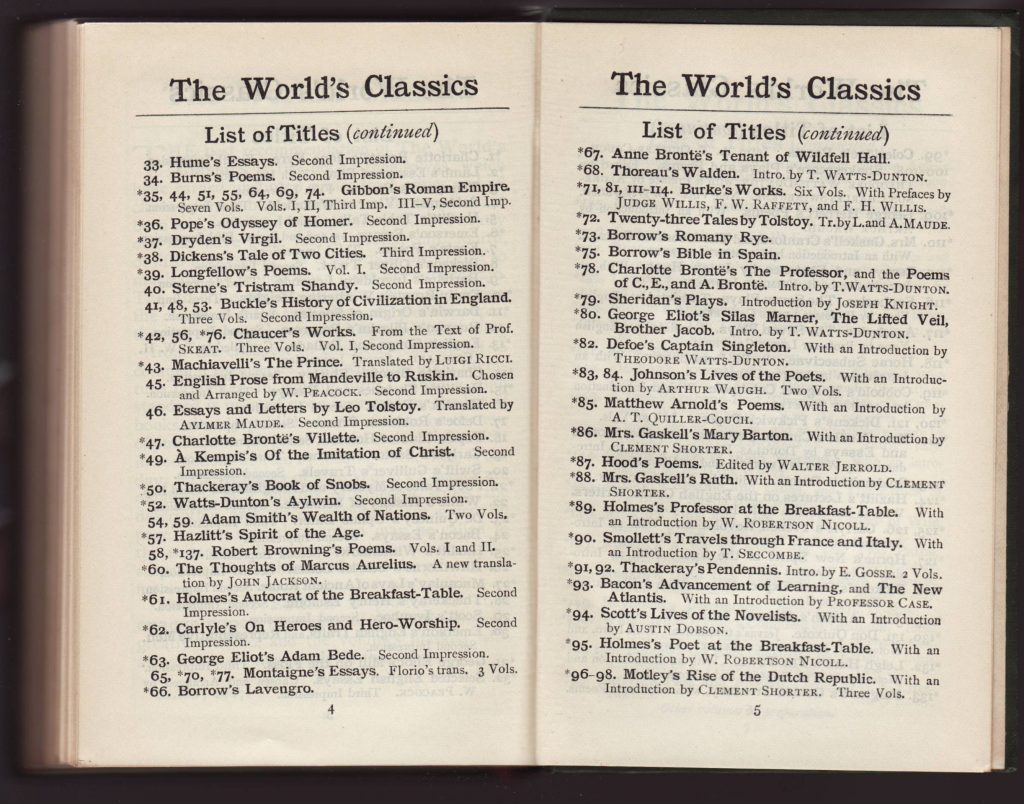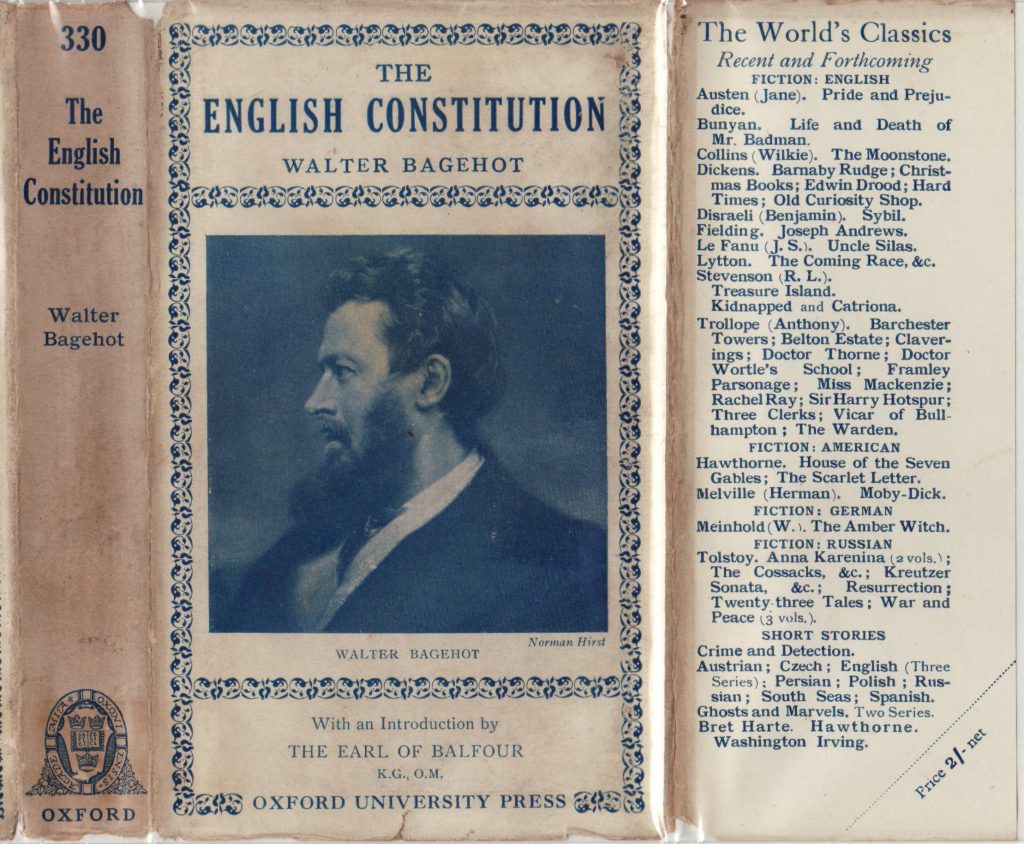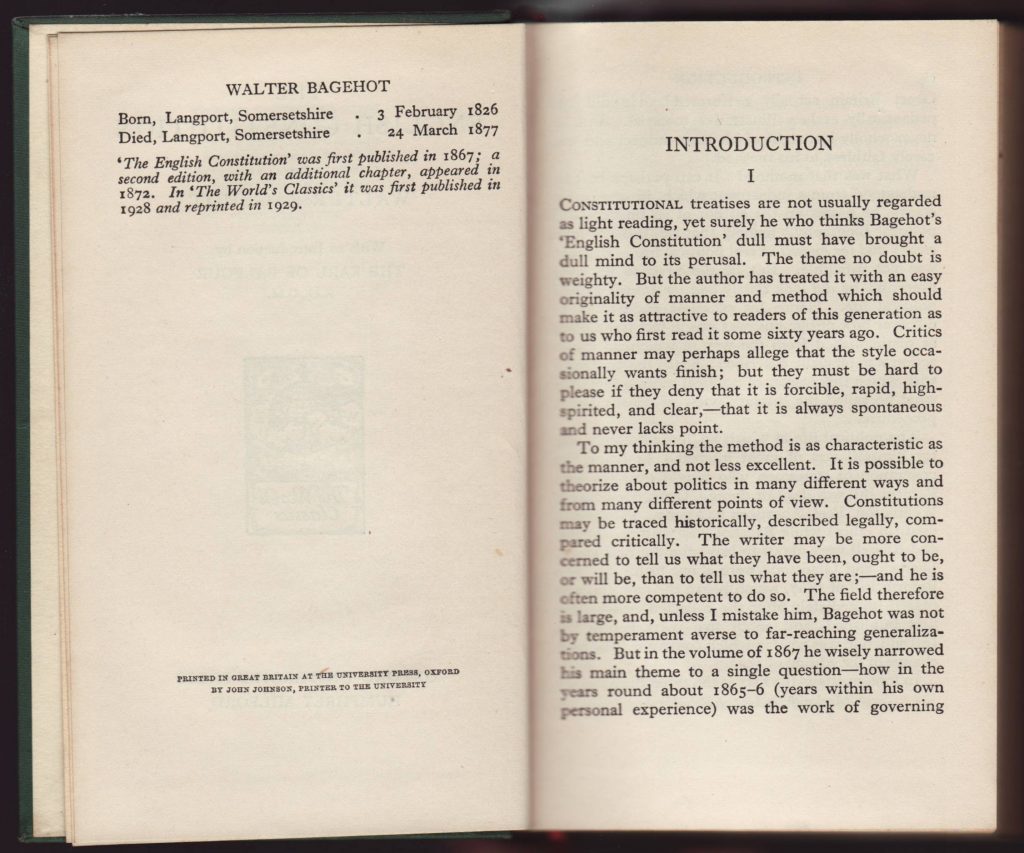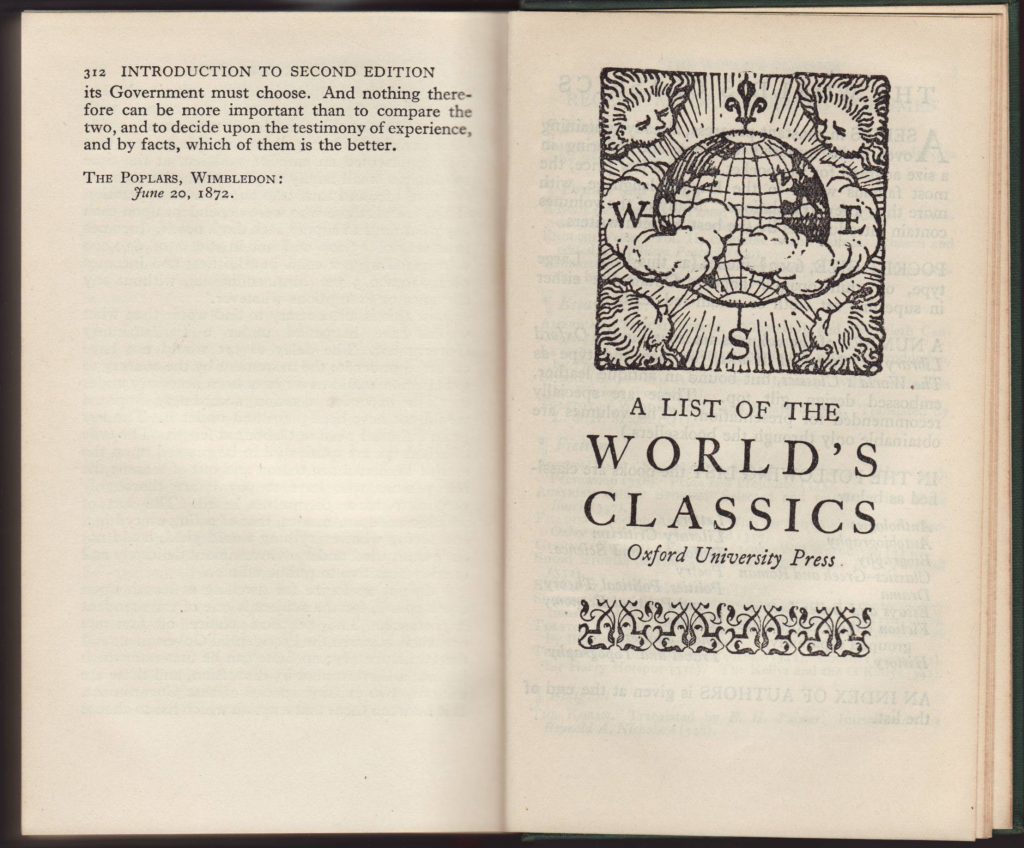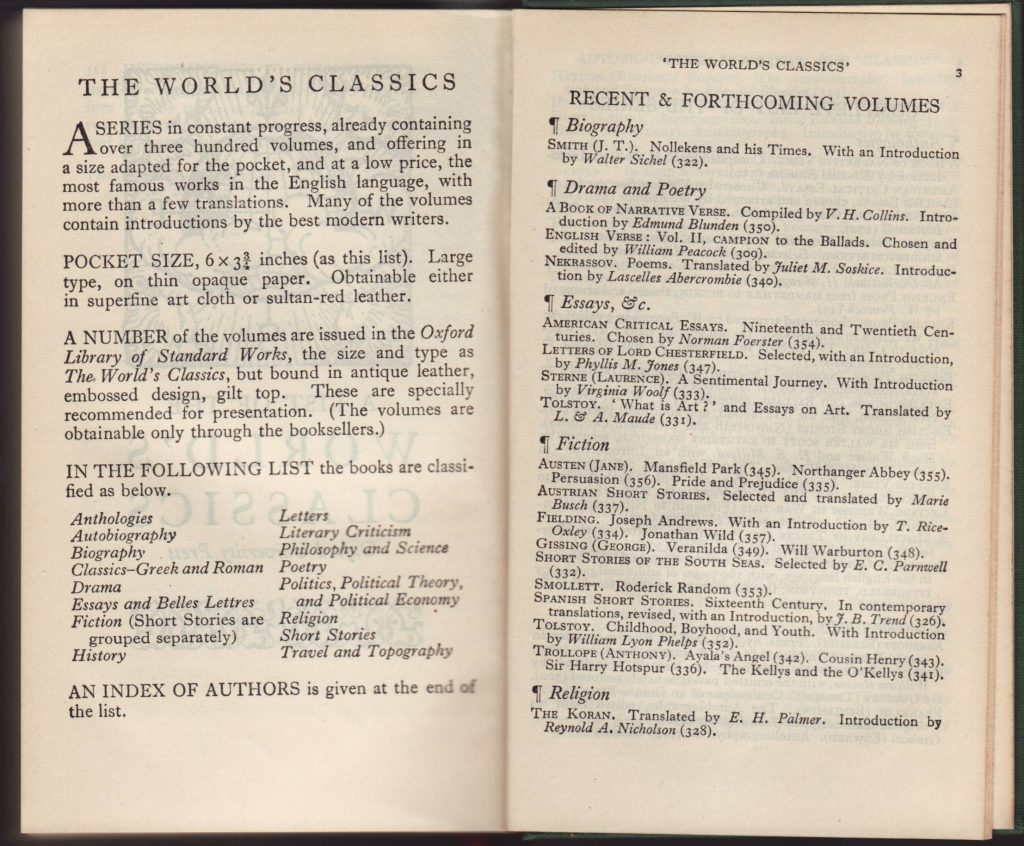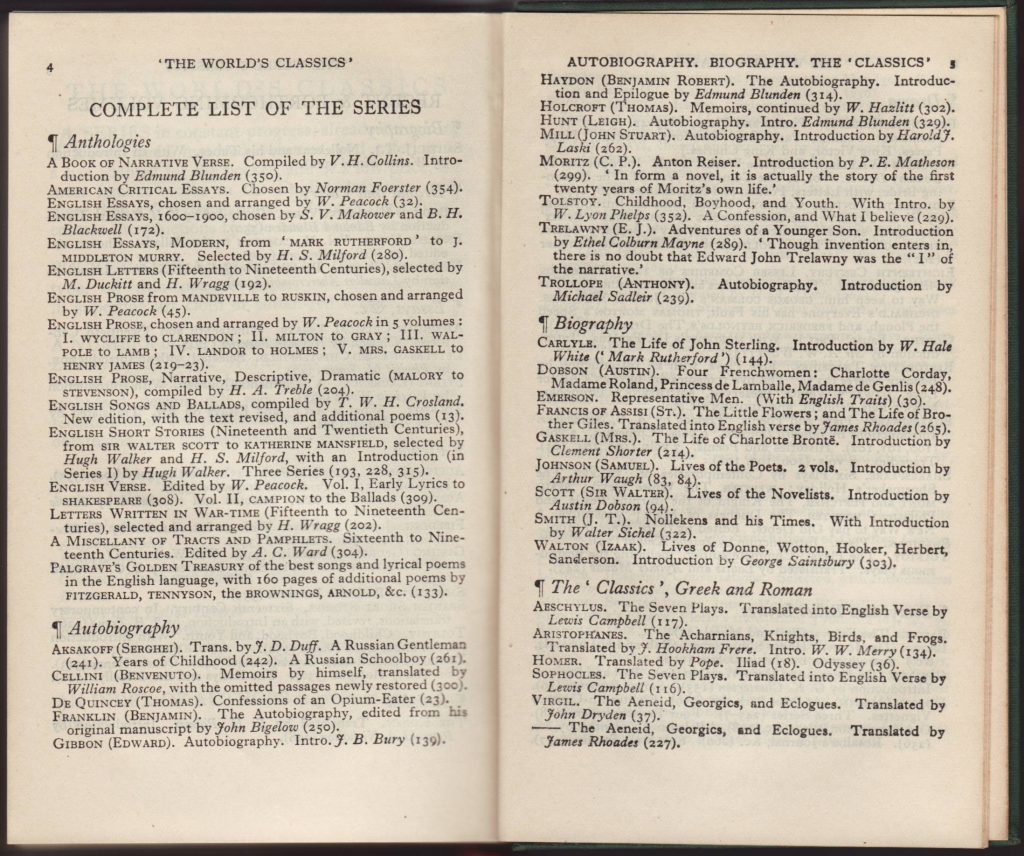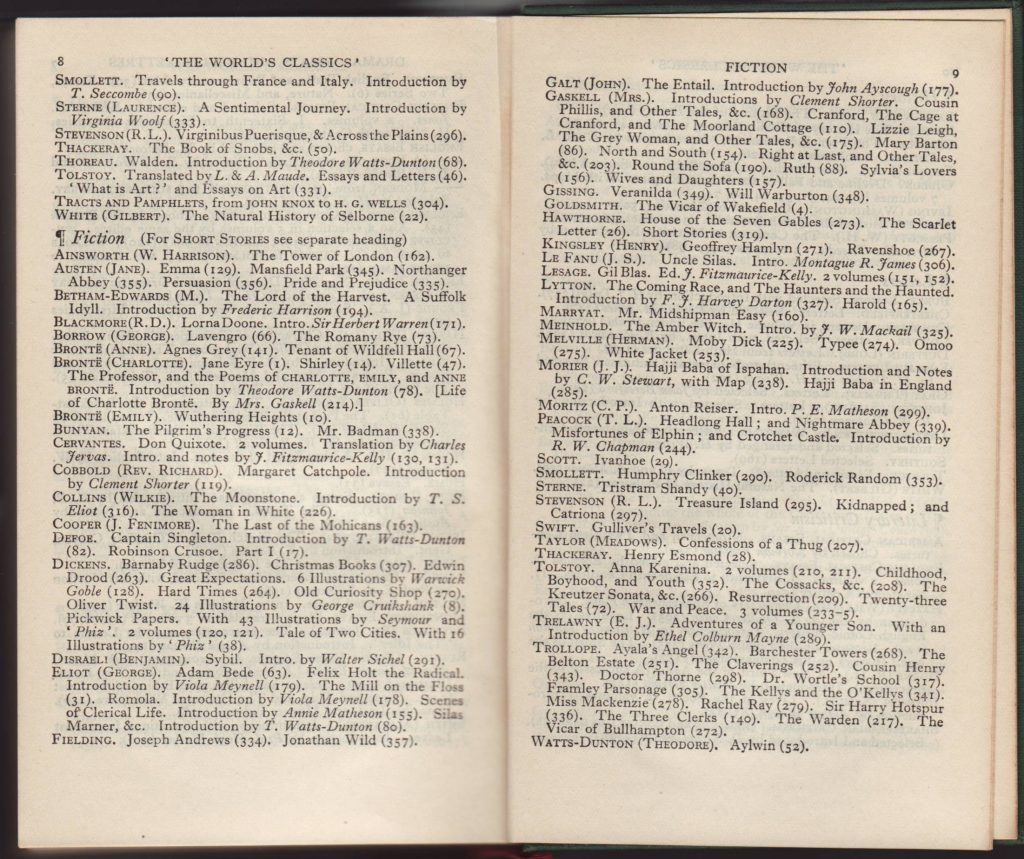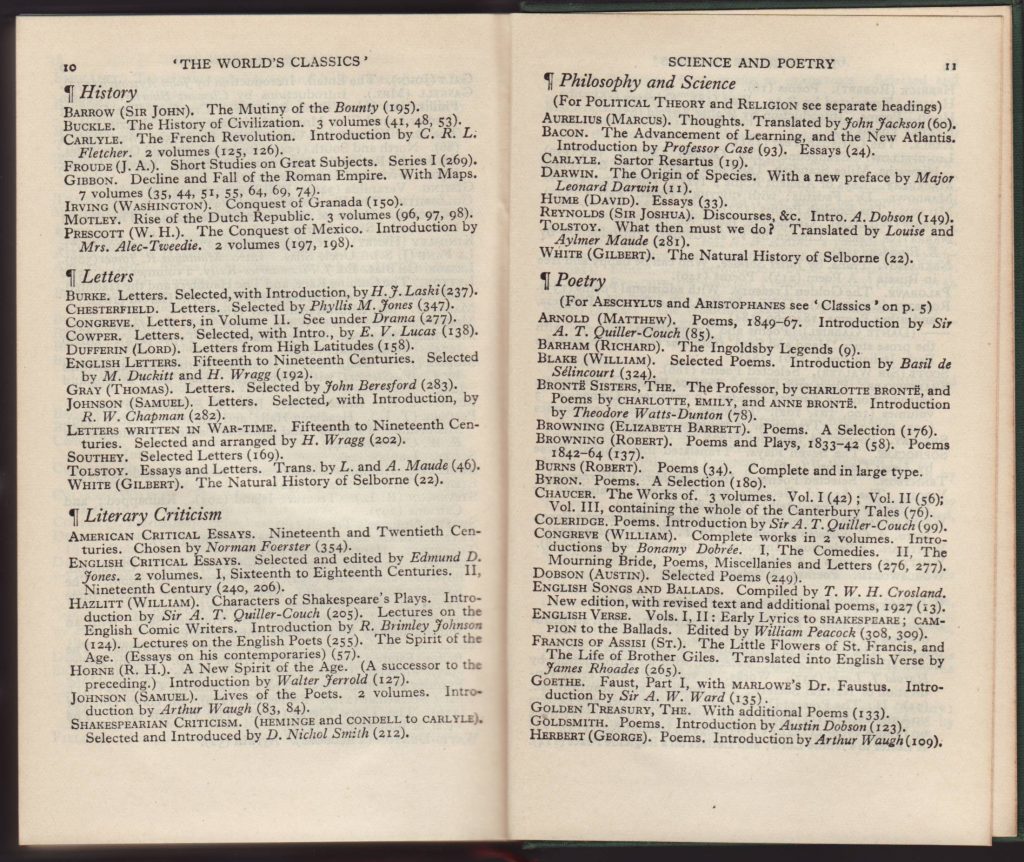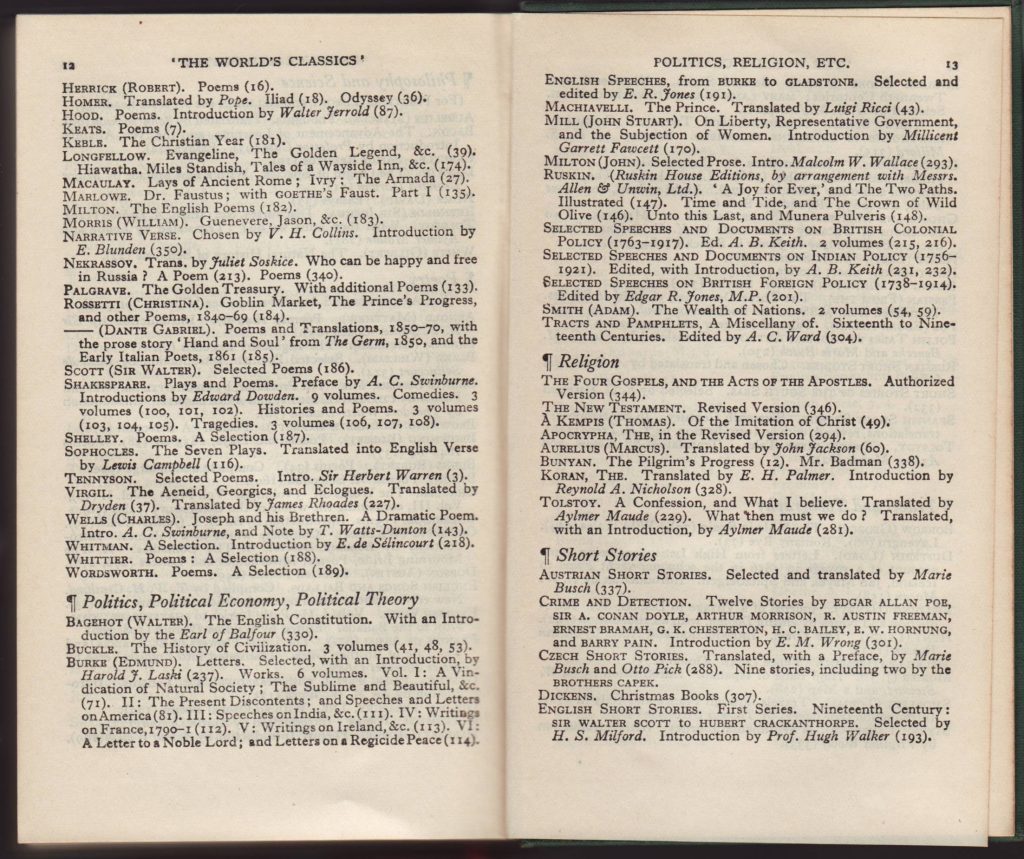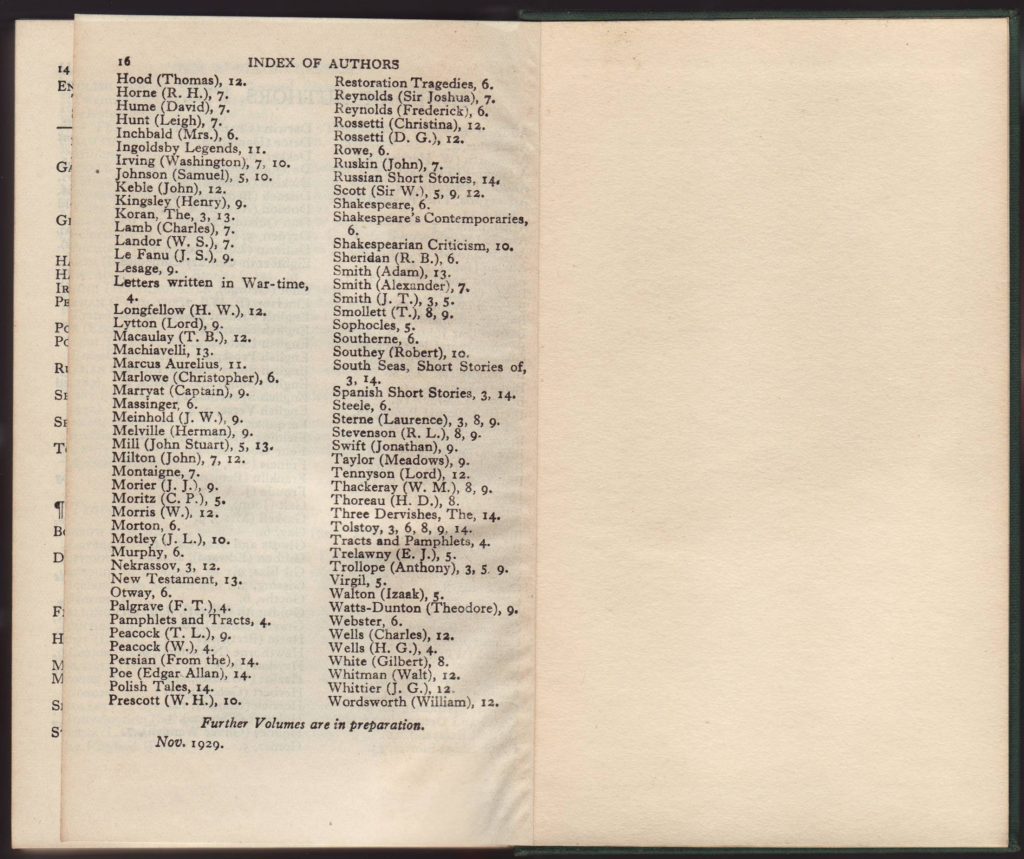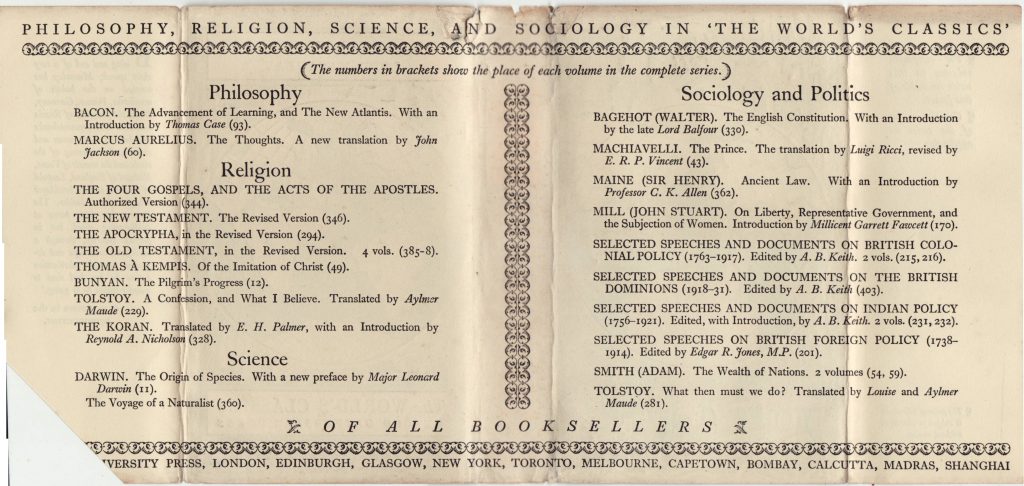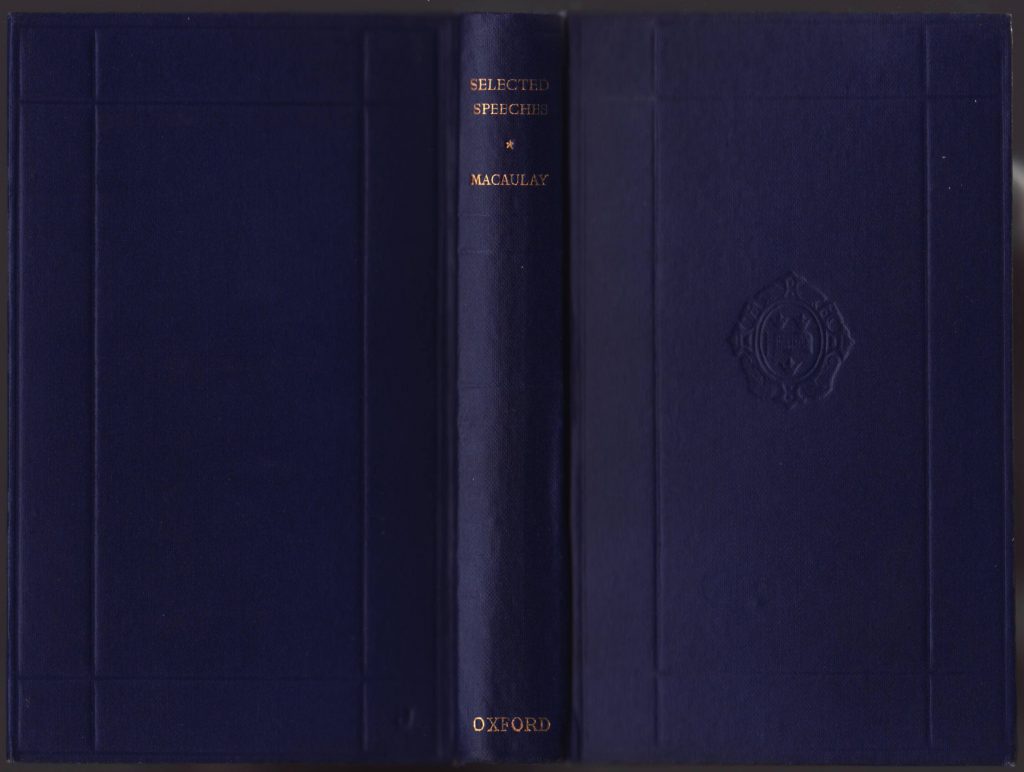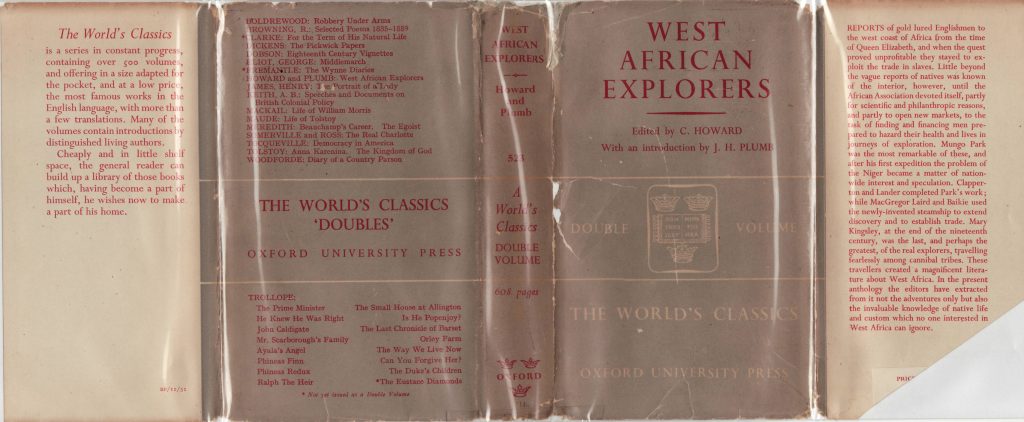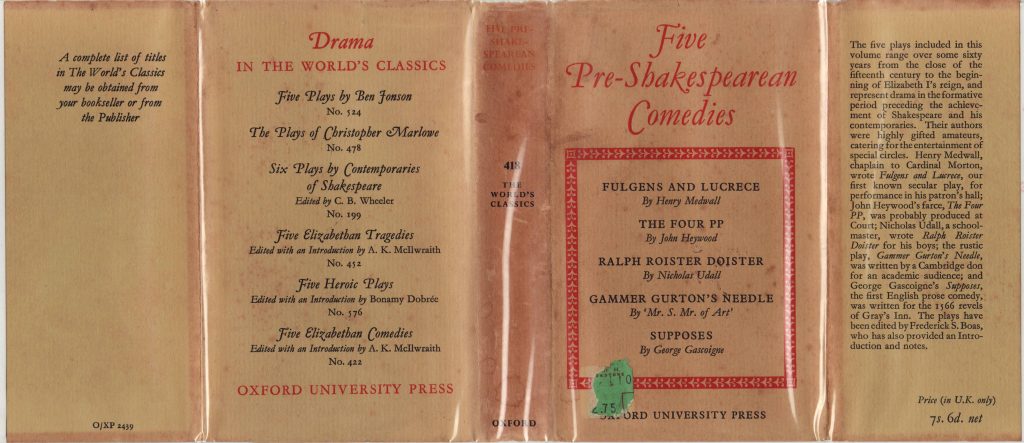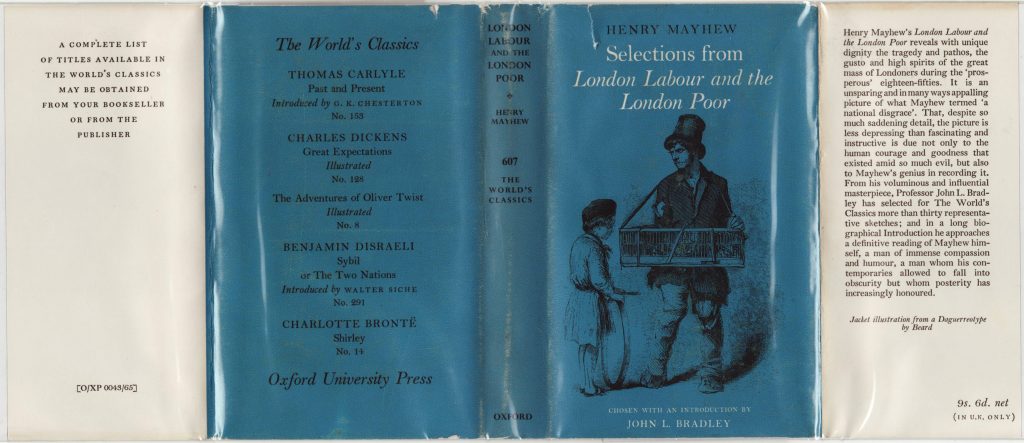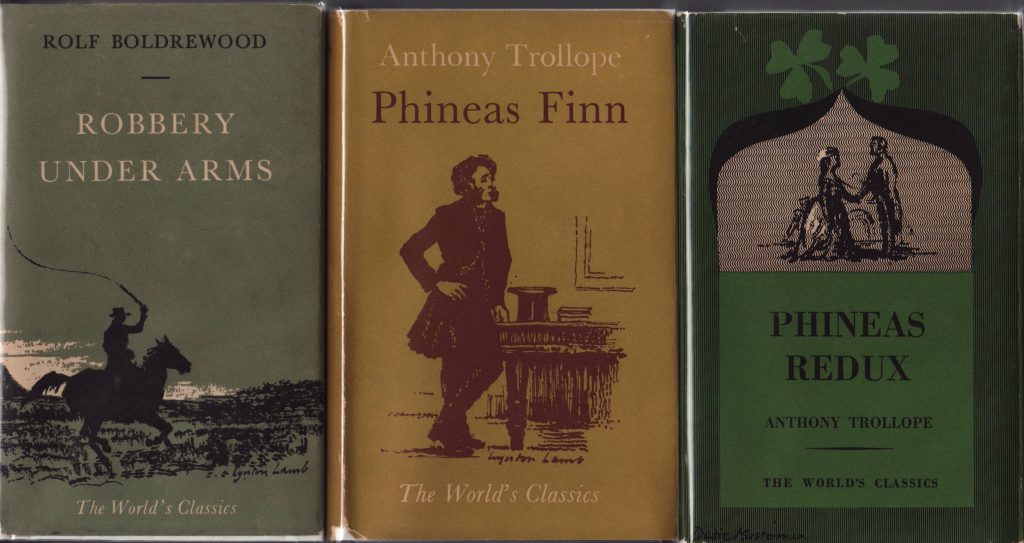Grant Richards (London, UK)
Series dates: 1901-1905
Oxford University Press (London, UK)
Series dates: 1905-date
Size: 4″ x 6″
George Allen (London, UK) (Ruskin titles only)
Series dates: 1907-1912
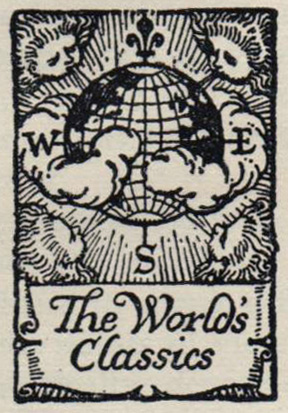
Oxford’s World’s Classics series is among a handful of series that sold many millions of books over much of the 20th century. It is also one of the smallest format series, at a diminutive 4″ x 6″ in size. London publisher Grant Richards initiated the series in 1901.
An article in the Review of Reviews, volume 24, 1901, reviews the new World’s Classics series and other publications from Grant Richards. The image above is from the article, and the rest of the article is here as a PDF.
In the July 3, 1903, edition of T.P.’s Weekly Grant Richards described the goals of the newly issued World’s Classics series:
In 1905 Richards went bankrupt and sold the World’s Classics to the Oxford University Press, at the time under the leadership of Henry Frowde. At the Oxford University Press, the series expanded to 900 titles by 1979 and several sub-series (World’s Classics Galaxy Editions, Double/Omnibus volumes) were issued. The series was redesigned and reissued in paperback and some hardcover editions in the 1980s.
The World’s Classics: A Library within a Library: an overview of a largely complete collection of World’s Classics titles.
A complete list of titles in the series with bibliographic details and sub-series can be found in “The World’s Classics” and “Oxford World’s Classics”: A Guide to the Clothbound Editions (and Their Variants). 2010. Compiled by J. Godsey, Geoffrey Milburn, and Nicholas Murray. (pdf here; archived here).
The earliest copies of the World’s Classics, published by Grant Richards from 1901-1905, have elaborate book spine decorations and probably were issued with dust jackets. See images of some of the World’s Classics titles from this era (without jackets) at The World’s Classics: A Library within a Library.
The series was redesigned and expanded starting in 1905, guided by Henry Frowde at the Oxford University Press. Early Oxford copies of the series have textual jackets, common to the series up to about 1917. The earliest jackets use red ink, printing only on the spine and front of the jacket. No serial number is included on the jacket (later copies are printed in black ink and include a serial number above the series name on the front of the jacket. The graphic element at the center of the jacket is also changed).
The copy of Ruskin’s A Joy For Ever / The Two Paths shown below and dated 1907 (from the catalog in the back of the book) is one of a dozen or so Ruskin titles in the World’s Classics which were initially printed and bound by the publisher George Allen as a Ruskin House Edition, named after Ruskin House, Allen’s headquarters in London.
George Allen was a pupil and friend of Ruskin, who in 1871 began to publish hand-crafted editions of Ruskin’s writings. The firm met with success, especially with Ruskin’s works, and moved to London around 1890. After Ruskin died in 1900 the publisher’s fortunes began to wane. Allen died in 1907 and his children began an effort to shore up the business, including acquiring publisher Bemrose (1909) and joining with Swan Sonnenschein & Co. (1911) to become George Allen & Co. The efforts did not work, and the firm slid further into economic difficulties. In 1914 Stanley Unwin, son of the family who owned Unwin Brother’s Publishing acquired the firm, which became Allen & Unwin Ltd. (source).
The Ruskin House Edition of the World’s Classics Ruskin titles was undoubtedly the result of Froude’s interest in including Ruskin titles in the World’s Classics and the family of George Allen seeking to shore up their failing firm. The Ruskin House Edition only appears in tandem with the World’s Classics series. These titles seem to be based on the earlier (1903) effort to publish the collected works of Ruskin, issued in more expensive and cheaper editions. In the Works series, A Joy For Ever / The Two Paths is volume 16.
The Ruskin House editions are the cheaper editions, issued as part of the World’s Classics series. Thus, simultaneously, these books are part of the Works of John Ruskin (published by Allen and Longmans, Green & Co.), the Ruskin House Edition (Allen and Oxford University Press), and the World’s Classics (Oxford University Press). This illustrates the manner in which a literary entity (Ruskin’s works) could be parsed out in different editions and series by different publishers to appeal to different segments of the book-buying public. The Ruskin House Edition appears on World’s Classics Ruskin titles until at least 1934.
A bibliography of The Complete Works of John Ruskin lists many of the reprint series that included Ruskin titles through 1912.
The dust jacket on this edition of A Joy For Ever / The Two Paths only indicates Henry Frowde and the Oxford University Press (there is no mention of Allen). The jacket design is in the Glasgow Style (Rennie Mackintosh) (thanks to Teddy Davidson for this insight).
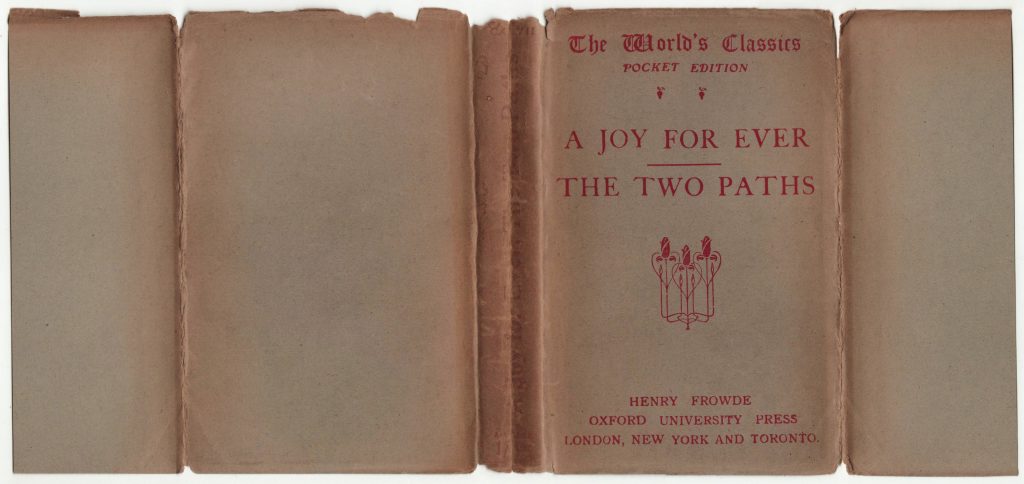
The jacket spine (here badly faded) includes the serial number at the top (in Roman numerals), the title, what seems to be “Art Cloth” (not one of the binding styles indicated in the catalog in the rear of the book, see below), and the price (1/-) at the bottom. The front of the jacket includes the series name, “Pocket Edition,” the title, a design, and the imprint. The series number for this book is not indicated on the jacket (later jackets from this era of the series are printed in black and include the series number above the series name on the jacket).
The rear and rear flap of the jacket is blank.
This cloth bound copy is bound in dark green with debossing on the front of the book and type and decorations in gold on the spine. George Allen is the publisher of the book, as indicated at the base of the book spine.
Intricate arts & crafts, Ruskinonian designs fill the book’s endpapers.
The half title page includes indications of all the roles this title fills: part of the World’s Classics, but also the Works of Ruskin and the Ruskin House Edition. It is unknown what the asterisk in the lower right corner indicates.
The verso of the title page includes the birth and death years of Ruskin.
The elaborately decorated title page faces a portrait of Ruskin. Again, as with the bookbinding, the title page only includes the Allen imprint. In addition, “The Works of John Ruskin” rather than the particular Ruskin titles, is included on this title page.
The reverse of the title page includes the number of copies printed of the two titles reprinted in this edition. Ballantine, Hanson & Co. of Edinburgh is the printer of the book. The title of the first of two works in the book follows.
The rear of the book has a detailed catalog of the World’s Classics series indicating the Frowde / Oxford University Press imprint (the only place in the book with the Oxford imprint).
There are ten different bindings in the Ordinary Edition of the World’s Classics, including Cloth, Sultan-red Leather, Buckram (with a paper label), Quarter Parchment, Lambskin, Parchment (half circuit), Quarter vellum (hand tooled and paneled), Half-calf, Whole Calf, and Tree calf. The prices were from 1/- net for the cloth to 5/6 net for the Tree calf binding.
A Pocket Edition (printed on thin paper) is available in cloth, sultan-red leather, and quarter vellum (from 1/- to 4/-).
This particular edition seems to be none of the above bindings, but instead what is called the “art cloth” binding, priced at 1/-. This probably has to do with the fact that Allen published and bound these particular World’s Classics titles.
A prospectus for the series follows the listing of binding styles, noting 130 volumes in print and dated October 1907. A numbered list of titles follows with an indication of the number of printings (as of October 1907) and additional information, such as volume editors and introductions. The asterisk indicates volumes printed in the Pocket Edition on thin paper. This may be what the asterisk on the title page of the book refers to.
The Ruskin titles appear as serial numbers 145 to 148 and all are Ruskin House Editions.
A related Oxford series, The Boys’ Classics, numbering 11 volumes, are advertised on the last page of the catalog. This juvenile series was originally published by Grant Richards, like the World’s Classics.
If you are over-run with World’s Classics titles, two oak bookcases are offered by Oxford University Press, to hold 50 (5s/) or 100 (18s/) copies of the World’s Classics.
Around 1915, illustrated jackets appear. Typically outlined with a decorative border, the jackets show images of the author or illustrate scenes from the book. This jacket design lasts until around 1929.
Walter Bagehot’s The English Constitution is a 1929 2nd printing in the World’s Classics (first, 1928). Jacket spines include the series number. The front of the jacket has the decorative frame, common to many titles at the time, with the author/title in one box and an illustration in another. The series name is not included on the jacket spine nor front. A list of recent and forthcoming titles in the series is included, with the series name, on the front jacket flap. A price (2/ net) is included on the jacket flap.
Recent and forthcoming titles are included on the rear jacket flap, and a list of popular titles is included on the back of the jacket.
The jacket points to a complete list (as of 1929) of titles at the rear of the book (see below).
Bindings are rather elegant green cloth with a subtle debossed design and gold lettering. The series name is not included on the book cover.
The series name heads the half-title page along with the book’s series number and the title of the book.
Information about the Oxford University Press faces the title page which includes a series logo.
Basic biographical information and printing information in the series are included on copyright page along with printing information.
A catalog (dated November 1929) is included in the back of this particular title.
A common globe design with extensive surrounding decorations is used from about 1926-1937. A copy of Macaulay’s Selected Speeches was first published in the series in 1935. The book’s serial number is on the top of the jacket spine. The series name is at the base of the front jacket cover, the author, and title at the top. A brief description of the book is included on the front jacket flap.
The reverse of the jacket includes related titles in the series:
The book’s binding is blue cloth with gold stamping and a different design from the 1929 title above.
A non illustrated common jacket design is also used in this era, from about 1935 to 1950.
Post-WW2 copies of the World’s Classics include common, textual jackets and illustrated jackets.
A copy of West African Explorers edited by C. Howard is a “double volume” in the series, published for the first time in 1951. The jacket design is used on numerous titles published after WW2.
A variation on the text jacket design is this 1961 fourth reprinting (first in series, 1950) of Five Pre-Shakespearean Comedies.
Illustrated jackets are used for a significant number of titles from the 1950s onward. This is the first printing in series 1965 edition of selections from Mayhew’s London Labour and the London Poor.
Additional illustrated jackets, all 1957 printings: Rolf Boldrewood’s Robbery Under Arms and Anthony Trollope’s Phineas Finn and Phineas Redux.









